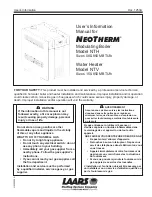
300ACDC
6
SEQUENCE OF OPERATION
6 – 2
Set UP SLOPE time.
Set (WELD) PEAK CUR current.
Set BASE current.
Set DOWN SLOPE time.
Set CRATER CUR current.
Pulse Mode parameters if required.
Set PULSE WIDTH % for PEAK CURRENT.
Set PEAK CURRENT.
Set PULSE FREQ.
Commence welding.
3
Slope Mode Sequence
Figure 6-2: Slope Mode Sequence
1. To start Slope sequence Close remote switch
contact. Once the welding arc is established
the Power Source will maintain initial current
setting as long as the remote switch contacts
are closed.
a. In the HF TIG mode, after Preflow time,
High Frequency is present at the torch.
When the torch is positioned close to the
work the welding current will transfer to the
work and establish the arc at the initial cur-
rent setting.
b. In the Lift TIG mode, after Preflow time, Lift
Start current is present at the torch. When
the electrode is touched to the work and
lifted off, the welding arc is established at
the initial current setting.
2. Open Remote Switch
–
current increases to
weld current. Once welding arc has reached
weld current the power source will maintain
weld current as long as the remote switch con-
tacts are open.
3. Close Remote Switch
–
Welding current
decreases to final current setting. Once final
welding current is reached the power source
will maintain final current setting as long as the
remote switch contacts are closed.
4. Open Remote Switch
–
Welding arc stops and
post flow begins.
4
Slope Mode with repeat
sequence
The repeat function is operated during the down
slope cycle of the Slope Sequence and is active
through the down slope period only. During the
down slope period by opening the Remote Switch
contacts the current will increase back to weld cur-
rent. Within the Down Slope period the repeat
function can operated as many times as desired.
To continue slope cycle and end slope sequence
close remote switch contacts and allow weld cur-
rent to reach final current setting. Once final cur-
rent setting is reached opening the Remote Switch
again will turn off the welding arc and post flow
begins.
5
Pulse Controls
The Pulse controls are used primarily to control
heat input. Pulse offers a number of advantages
as follows:
1) Control puddle
–
size and fluidity (especially
out of position).
2) Increase penetration.
3) Travel speed control.
4) Better consistent quality.
5) Decreased distortion on lighter or thinner
materials.
Pulse-current provides a system in which the weld-
ing current continuously changes between two lev-
els. During the periods of Peak current, heating
and fusion takes place, and during the background
(base) current periods, cooling and solidification
take place. Pulse Width is the time in one cycle the
current remains at the peak current setting. Pulse
Frequency, measured in Hertz, is the number of
cycles per second the current travels between
peak and background current settings. It is as if
the foot rheostat were moved up and down to
increase and decrease the welding current on a
regular basis. The faster you move the foot rheo-
stat up and down the faster the frequency.
Weld Current
Down
Slope
Up
Slope
Initial
Current
Switch
Closed
Switch
Open
Switch
Closed
Switch
Open
Preflow
Final
Current
Postflow
(Peak Current)
(Base)
Background
Current
(Pulse Width)
(Pulse Frequency)
Summary of Contents for ARCMASTER 300 AC/DC
Page 2: ......
Page 31: ...300ACDC 5 SET UP FOR SMAW STICK AND GTAW TIG 5 2 PAGE LEFT INTENTIONALLY BLANK ...
Page 35: ...300ACDC 7 ROUTINE MAINTENANCE 7 2 PAGE LEFT INTENTIONALLY BLANK ...
Page 41: ...300ACDC 8 BASIC TROUBLESHOOTING 8 6 PAGE LEFT INTENTIONALLY BLANK ...
Page 109: ...THIS PAGE LEFT INTENTIONALLY BLANK ...
Page 113: ......















































